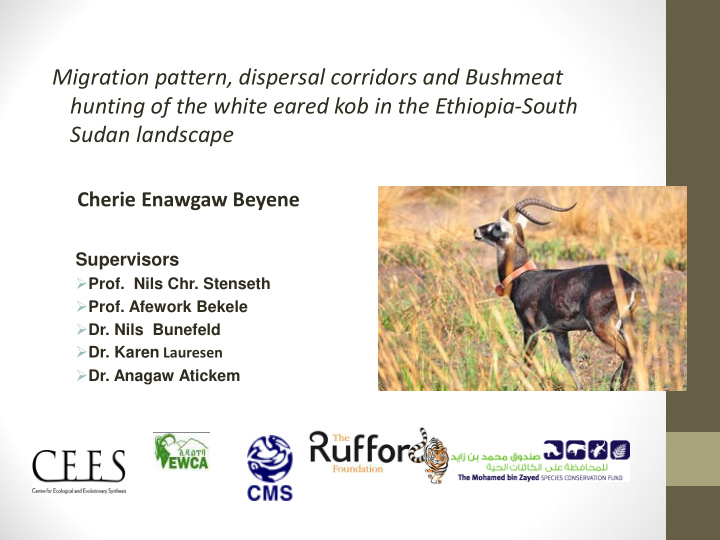



Migration pattern, dispersal corridors and Bushmeat hunting of the white eared kob in the Ethiopia-South Sudan landscape Cherie Enawgaw Beyene Supervisors Prof. Nils Chr. Stenseth Prof. Afework Bekele Dr. Nils Bunefeld Dr. Karen Lauresen Dr. Anagaw Atickem
Introduction Migration is a round trip movement usually between two locations Dispersal- movement beyond distribution limits Corridors- favorable habitat connecting larger ones Migratory mammals of the world sharply declining Cutoff dispersal corridors Bushmeat hunting Climate change Migratory ungulates, eg. Wildebeest, are derived by continuously changing resource (Holdo et al 2009), White eared kob--- against rainfall
White eared kob migration About a million white eared kob crossing the Ethiopian- southern Sudan landscape -second largest mammal migration on earth No detailed research conducted on migration pattern and dispersal corridor of white/ eared kob My PhD research project aims to determine Movement pattern and dispersal corridors Habitat preference and breeding ground Environmental factors driving migration impact of bushmeat hunting on the migration
Studyarea: 114,434 km 2 as measured from minimum convex polygon
Methods 1. Satellite collaring 45 collars were fitted (19 male 26 female)_EWCA And HoAREC/N 2013 Land cover analysis from satellite image and ground truthing Questionnaire survey for bushmeat hunting assessment
Dispersal behaviour; 14 were resident 7 Female , 5 Male 23 were migrated • 16 Female , 19 male traveled over 250 km- aerial distance
Dry and wet season distribution Wet season distribution Dry season distribution
Habitat suitability map Vegetation mapping underway
Movement pattern Dry season Wet season
Dispersal corridors
Dispersal corridors
Bushmeat hunting • Focus group discussion was conducted with 15 village representatives • 120 individuals were interviewed following predetermined questioners, • Additional data will be collected in dry season Initial finding shows that white eared kob is the most commonly hunted species Wildlife meat, mainly white eared kob, being used to feed troops and displaced people in South Sudan
Thank you!
Recommend
More recommend